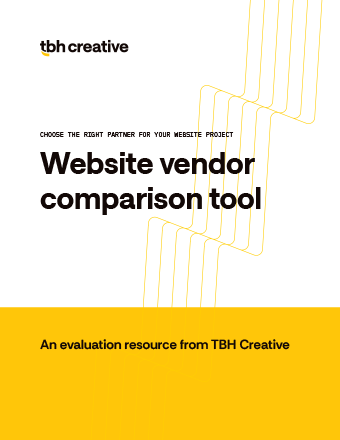What’s the secret to great healthcare website design?
Below we outline 6 key components for a successful website redesign, complete with industry best practices and emerging trends.
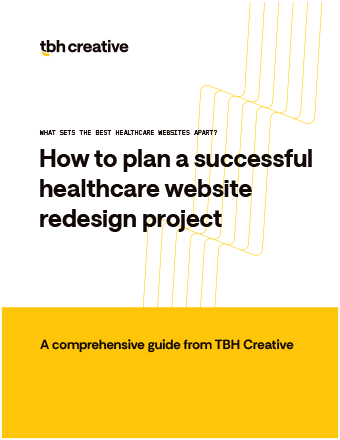
In this guide, we’ll walk you through best practices for making your health system website a potent force-multiplier in your overall healthcare marketing plan.
It’s time to upgrade your website design and strategy if…
You've outgrown your website.
Your competitors have better websites.
You're website isn't showing results.
You aren't getting enough visitors to your site.
Patients don't use your site.
You can't make the changes you want or important features don't work.
Site audit
When it comes to healthcare web development, you can’t afford to skip over your baseline assessment. Audit your current website and consider how things are functioning.
- What is working? What is not?
- Is your site responsive and optimized properly for smaller screens and devices?
- What does the website look like? Do the colors and structure match your brand identity?
- What types of analytics are you tracking? What do the numbers say about your site’s effectiveness?
- What tools do you have in place for users to interact? Do people use them? Do they need improvements?
- What do your patients and employees say about the website?
- How much of your content is accurate?
- Is information easy to find?
- How is your technical SEO and local organic search rank position?
- What can you control on the site with your CMS? What is hard-coded?
- How much time and ability do you have to work on this project in-house, and how much do you have budgeted?
If you’re struggling to kick off your internal site audit, we can help. Oftentimes, a third party can help provide a holistic, unbiased perspective alongside your team of subject-matter experts.

Download our Healthcare Redesign Getting Started Checklist
This checklist will help you prepare for healthcare website redesign project success.
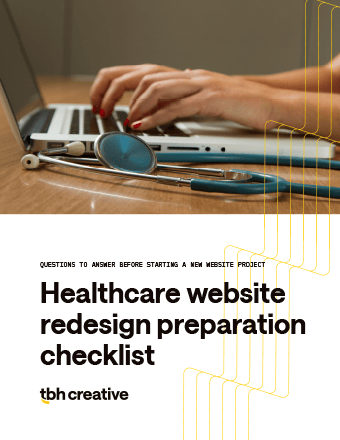
Team creation
Organizational structure may determine some of your team members, but taking the time to designate authority with clear roles and responsibilities can save you a lot of headaches during the development process.
Ensure you meet your goals by defining:
- What web design, development, copywriting, and technical skills do you have in-house?
- How many people and how much employee time can you devote to the project?
- How much of the work do you want to outsource? How much outsourcing can you afford?
- Who are the stakeholders in your organization? Whose opinions should be consulted and at what points in the process?
- Who needs to approve content and design? What will the sign-off process look like?
- What roles will each person on the team fill, and what does their availability do to your timeline?
Not sure how to set up your team?
It is important to involve all key stakeholders from the beginning. We recommend spending time on an important foundation step: selecting the best internal team.
Learn how the best healthcare websites structured their design project
As you build your team, you may need to outsource part of the work—either to current partners or new teams with experience in healthcare website design.
Before starting a website redesign project is a great time to evaluate existing partnerships and make sure that they have kept pace with your growth and mission.
- Have you outgrown your web design or digital marketing agency?
- Do other agencies have the capabilities and capacity to better meet your needs?
- Do you like the complexity and functionality of the work your partners do?
- Do you need a new partner that can do more than website redesigns?
- Are you satisfied with your agency’s SEO capabilities?
- Are you ready for other digital marketing services?

Download the Website Vendor Comparison Tool.
Use this checklist to simplify the process of evaluating your top web company choices—plus questions to ask
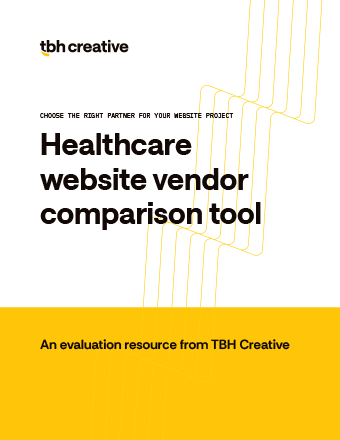
Strategy development
In today’s environment, you can’t afford to be anything less than strategic when it comes to your healthcare marketing. The best healthcare websites use a carefully developed voice and structure designed to reach ideal patients and achieve clearly defined business goals.
A thoughtful approach ensures that you prioritize the right design, functionality, structure, and content to produce measurable results.
Your patients expect clarity, warmth, and expert care from your organization, and no less from your website.
- Who are your ideal patients? Who are you trying to reach?
- What service lines do you want to promote most? What services are patients looking for and/or not aware that you offer?
- What concerns do your patients commonly have? What information do they need in order to select your organization or provider?
- How are they feeling when seeking out help? What are their concerns?
- How do your target patients access the Internet?
- What types of functionality might help patients understand or become more comfortable with your services?
- What other business needs could be served through design?
The first step in building an effective website is gaining a clear understanding of your website users (patients, referring physicians, caregivers, or loved ones). We call this persona research.
DEVELOPING WEBSITE PERSONAS
What do your users need?
A persona is a detailed profile of your ideal audience, compiled from interviews and research, that helps you better understand how to reach and communicate with your target customer.
You may already have a good idea about the types of people who use your website, but do referring physicians and patients use your site the same way? How about administrators? How do their differences affect the way they navigate the pages?
Persona research involves learning as much as possible about the people who fit your key audience profiles. You need to learn how they use the Internet in general, how their lifestyles affect the way they interact with your organization, and what they really need from your website. Armed with that information, you can design your new healthcare website to communicate more effectively, and get better results.
Setting your website goals
What do you expect your new website to do?
Once you have completed persona research, take the time to articulate your business goals, then prioritize them and determine how you will track and measure them.
Once you have completed persona research, take the time to articulate your business goals, then prioritize them and determine how you will track and measure them.
- Do you want to increase appointments?
- How would you like to grow select patient demographics?
- Is your goal to build awareness around a specialty or procedure?
- Are you having a hard time attracting the right job applicants?
- Do you need patients to select caregivers or submit forms online?
Using your persona research and goals, your healthcare web development team can suggest targeted solutions that make sense for your organization. This could take the form of one overarching strategy or a series of linked plans for different sections. It might also require supporting promotional campaigns using a variety of marketing tactics.
One important aspect of any strategic plan for healthcare website design is site architecture. The way patients navigate your site and how you organize content impacts your audience’s user experience, and whether you meet your business goals.
Another part of your strategy needs to be measurement. After defining your goals, make a plan for checking baselines. Think about how you will pull together reports after launch, then set up the right tracking tools, and think about how you’ll handle different outcomes.
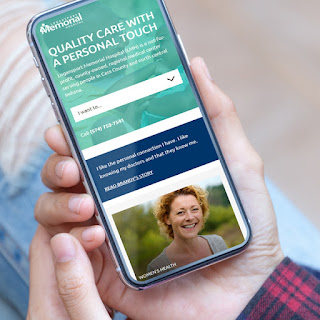
Timeline assessment
How long will your healthcare web development project take? Realistically, when can you expect to launch a redesigned website?
Because each organization’s needs, budget, and capacity are different, website project timelines can vary significantly. To build a workable schedule, be sure you consider the full scope of work and appropriate review times at each step, as well as testing time.
Review the tasks involved
- Build-in time to create SEO content and ensure HIPAA compliance. Your content has to speak effectively to your target audience, while also satisfying regulatory requirements and feeding search engine algorithms.
- As you consider design time, be practical about your approval process, and build in time for review and iteration.
- Factor in time for designing, building, and testing any custom tools and functionality you require.
- Take technical, behind-the-scenes tasks into account. With a redesign, you need to plan time for a redirect plan, testing links, and new coding.
Reassess your bandwidth
- Can you, in fact, do any of the tasks you defined in-house?
- Where does it make more sense to outsource? Remember, employee time costs your organization just like paying a contractor does—in many cases, it’s more cost-effective to pay the faster expert.
- How will you plan for and enforce review time for stakeholders who need to approve various stages of design and deliverables?

Build and launch
Now all of your up-front work begins to pay off, and it’s time to start designing and developing your new site. When you take a strategic approach to healthcare website design, projects run more smoothly and stick more closely to deadlines. Of course, no plan perfectly anticipates every eventuality, and there will still be unexpected roadblocks and plenty of moving parts.
During your project, be sure you monitor your team’s progress and track benchmarks regularly. Establish a routine of regular check-ins and reports, and give your team permission to tell you when it looks like a deadline needs to be adjusted. Some steps have to proceed in order, but others can be worked on simultaneously.
Although all projects are different, here are some best practices and tips we learned while working on a variety of successful healthcare website design projects:
Give wireframes appropriate priority. Spending time on wireframes upfront saves headaches and expensive rework later on. Being sure that content elements are positioned with priority and that nothing is missing before you start the time-consuming high-fidelity design work or coding.
Define site architecture early. During content planning, define page structure and labels, interlinking opportunities, keyword targets, and desired audience journeys and actions so that your site is designed to meet your goals.
Streamline content production. Keep your design and content teams in sync so the copy and templates work together. Include META data, URL naming, photo specifications, and other page-level notes in content documents to streamline the production process and reduce the time required to build each page.
Build functionality testing into the timeline. Work out the details of application functionality early in the process. Make sure you allow appropriate time for testing all interactive features and making any needed improvements prior to launch.
Remember approvals. Don’t forget to loop key project stakeholders in at all major stages. Getting approvals along the way prevents rework in later stages and saves time in the long run.
Schedule enough time for thorough production. Healthcare websites tend to have a lot of pages. Make sure you include adequate time in your schedule to add your content to your new site. You’ll want to have enough time to pay special attention to detail for photos, formatting, and other page-level details. This is particularly important in healthcare websites, which tend to have a lot of pages.
Launch Rejoice
You launched your site, now what?
The best healthcare websites are iterative and integrate with all aspects of your marketing strategy. After your new website launches, it should be used as a tool to drive smarter marketing campaigns, direct more effective ads, and achieve your broader business goals.
Ongoing improvements
Now that you have a new healthcare website, why not use it to propel your healthcare marketing to a new level? Consider your site in light of your overall marketing plan:
- Which pages make the best landing spots for ad campaigns or social media content?
- Can you link key web pages within existing email marketing workflows?
- How can you integrate the website into your social media strategy?
- What features or functions were deprioritized in phase one and might now move into consideration?
- What content might benefit from greater consideration or additional resources?
- Who/how will you keep adding more content and improving your SEO visibility?
- Which of your business goals might be met by adding to existing website content? Could you expand your
- vision to use the website for fundraising or media awareness?
- What are the analytics telling you?
- What ideas does your web design agency bring to the table?
Given the time and effort you put into developing your new site, you’ll want to keep it fresh and functional as long as possible. Scheduling time for routine maintenance can extend the lifespan of your website significantly—far beyond the commonly accepted three-year redesign cycle.
You’ll want to make time for:
- Handling technical updates
- Performing semi-annual audits and analytic reviews
- Making iterative improvements every month (or quarter) to keep the site updated without overwhelming your team’s workflow
Learn everything you need for a successful healthcare website redesign
How to build a successful healthcare website redesign project
Download your copy of our helpful guide The Secret Steps to Great Healthcare Website Design.
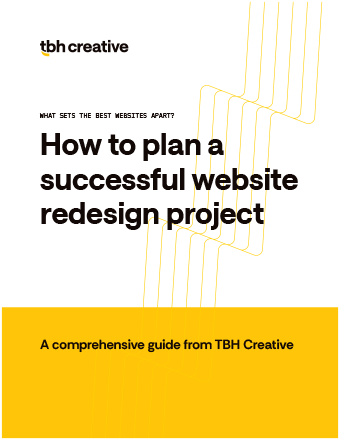
Latest blog posts
About TBH Creative
As an Indianapolis web design company specializing in sophisticated custom solutions, TBH Creative often serves healthcare clients.
Since 2004, we’ve partnered with small practices and large networks of hospitals and affiliated practitioners, and we use our experience in strategy, custom development, digital marketing, and user experience to deliver features and functionality that set our clients apart and comply with regulatory requirements.
And, we don’t stop being your partner after your website launches. TBH Creative believes in the power of ongoing collaboration.
Whether your next steps involve integrating digital marketing, adding new tools and features, or making routine improvements to extend the life of your website, TBH Creative is here to provide ongoing support and strategic insights.
The TBH Creative process begins with strategy and our recommendations driven by your goals. We believe in clear communication, high standards of excellence, and beating deadlines. But beyond those ideals, what drives the heart of our business is your mission—helping you serve your patients better with digital marketing and design than you ever thought possible.
Our Indianapolis web design company was named a top women-owned business in 2024 by Clutch, and best web designers for 2025 by Expertise.com.


